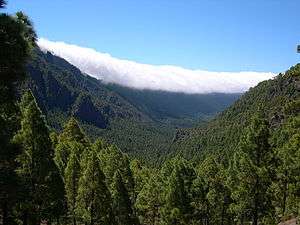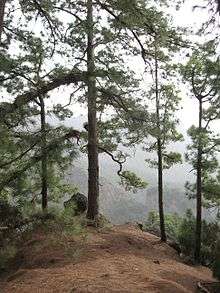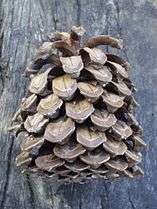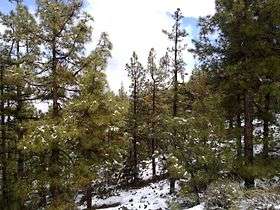Pinus canariensis
Pinus canariensis, the Canary Island pine, is a species of gymnosperm in the conifer family Pinaceae. It is a large, evergreen tree native and endemic to the outer Canary Islands (Gran Canaria, Tenerife, El Hierro and La Palma) in the Atlantic Ocean.[2] It is a subtropical pine and does not tolerate low temperatures or hard frost, surviving temperatures down to about −6 to −10 °C. Within its natural area, it grows under extremely variable rainfall regimes, from less than 300 mm (12 in) to several thousands, mostly due to differences in mist-capturing by the foliage. Under warm conditions, this is one of the most drought-tolerant pines, living even with less than 200 mm (7.9 in) of rainfall per year. It is the vegetable symbol of the island of La Palma.[3]
| Pinus canariensis Canary Island pine | |
|---|---|
 | |
| Canary Island pines in Caldera de Taburiente, La Palma | |
| Scientific classification | |
| Kingdom: | Plantae |
| Clade: | Tracheophytes |
| Division: | Pinophyta |
| Class: | Pinopsida |
| Order: | Pinales |
| Family: | Pinaceae |
| Genus: | Pinus |
| Subgenus: | P. subg. Pinus |
| Section: | P. sect. Pinus |
| Subsection: | Pinus subsect. Pinaster |
| Species: | P. canariensis |
| Binomial name | |
| Pinus canariensis C.Sm. | |
Distribution
The native range has been somewhat reduced due to over-cutting so that only the islands of Tenerife, La Palma and Gran Canaria still have large forests. Really big trees are still rare due to past over-cutting.[1] It is the tallest tree in the Canary Islands.

Description
Pinus canariensis is a large evergreen tree, growing to 30–40 m (98–131 ft) tall and 100–120 cm (39–47 in) trunk diameter (dbh), exceptionally up to 60 m (200 ft) tall and 265 cm (104 in) diameter.[2] The green to yellow-green leaves are needle-like, in bundles of three, 20–30 cm long,[2] with finely toothed margins and often drooping. A characteristic of the species is the occurrence of glaucous (bluish-green) epicormic shoots growing from the lower trunk, but in its natural area this only occurs as a consequence of fire or other damage. This pine is one of the most fire-resistant conifers in the world. The cones are 10–18 cm (3.9–7.1 in) long, 5 cm (2.0 in) wide,[2] glossy chestnut-brown in colour and frequently remaining closed for several years (serotinous cones). Its closest relatives are the Chir Pine (Pinus roxburghii) from the Himalaya, the Mediterranean pines Pinus pinea, Pinus halepensis, Pinus pinaster and Pinus brutia from the eastern Mediterranean.
Fossil record
Fossils of Pinus canariensis have been described from the fossil flora of Kızılcahamam district in Turkey which is of early Pliocene age.[4]
Cultivation and uses
The tree's extremely long needles make a significant contribution to the islands' water supply, trapping large amounts of condensation from the moist air coming off the Atlantic with the prevailing north eastern wind (locally called "alisios"). The condensation then drops to the ground and is quickly absorbed by the soil, eventually percolating down to the underground aquifers.
The aromatic wood, especially the heartwood, is among the finest of pine woods - hard, strong and durable.
In mainland Spain, South Africa, Sicily and Australia, it has become a naturalized species from original landscape uses.
Pinus canariensis is a popular ornamental tree in warmer climates, such as in private gardens, public landscapes, and as street trees in California.
Gallery
 Trunk
Trunk Epicormic shoots
Epicormic shoots_in_Presa_de_las_Ni%C3%B1as_02_(cropped).jpg) Immature male cone of a Pinus canariensis in Gran Canaria
Immature male cone of a Pinus canariensis in Gran Canaria Mature opened female cone
Mature opened female cone Figure on timber
Figure on timber Fire-resistant trunk
Fire-resistant trunk Vilaflor, Tenerife
Vilaflor, Tenerife Tenerife south
Tenerife south_01_ies.jpg) Pinus canariensis, Santa Cruz
Pinus canariensis, Santa Cruz Pinus canariensis forest, La Palma
Pinus canariensis forest, La Palma Pinus canariensis Caldera de Taburiente
Pinus canariensis Caldera de Taburiente Tenerife
Tenerife Gran Canaria
Gran Canaria- Male cones of Pinus canariensis photographed in Temecula, CA, USA
References
- Farjon, A. (2003). "Pinus canariensis". IUCN Red List of Threatened Species. 2003. Retrieved 11 October 2012.CS1 maint: ref=harv (link)
- C.A.B. International (4 April 2002). Pines of Silvicultural Importance: Compiled from the Forestry Compendium, CAB International. CABI. p. 35. ISBN 978-0-85199-539-7.
- "Ley 7/1991, de 30 de abril, de símbolos de la naturaleza para las Islas Canarias". Archived from the original on 2011-08-08. Retrieved 2016-09-25.
- Kasaplıgil, B.-(1975): Pliocene Flora of Güvem village near Ankara, Turkey, Abstracts of the Papers Presented at the XII International Botanical Congress, Akademika Nauk SSSR, 1: 115, Leningrad
External links
| Wikimedia Commons has media related to Pinus canariensis. |
